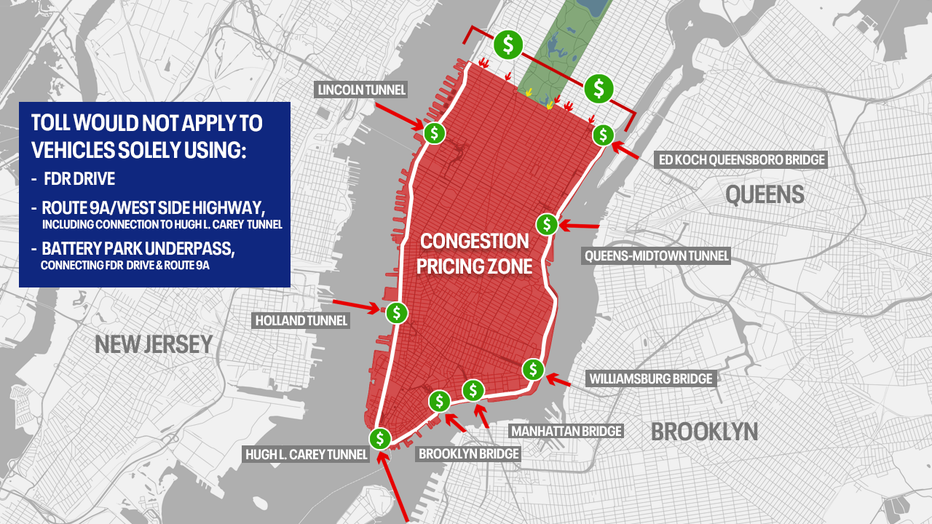Long Island businesses grapple with NYC's congestion pricing costs

Congestion pricing's cost for Long Island businesses
Some businesses on Long Island say congestion pricing is putting an extra squeeze on their bottom line. FOX 5's Jodi Goldberg has the story.
NEW YORK - All week long, FOX 5 has been taking a closer look at how congestion pricing is impacting different neighborhoods and groups of people across the five boroguhs and in the tri-state.
On Long Island, local companies who deliver to Manhattan's central business zone say the added costs are creating significant challenges.
RELATED: NYC congestion pricing in effect: Drivers' guide for map, costs and exemptions
Contractors feeling the crunch
Local perspective:
Ben Jackson, president of Ben’s General Contracting, says his company has no choice but to absorb the added expenses.
"I have to be able to work wherever my clients need me," Jackson said.
Many of his projects take him into Manhattan, where charging customers for estimates within the congestion pricing zone would likely send them to competitors.

NJ mayor talks 'reverse congestion pricing' toll
Jersey City Mayor Steven Fulop, who's also running for NJ governor, is floating the idea of a reverse congestion pricing toll. He joined Good Day New York to explain.
"Now I'm making less because I'm working in those areas. My supplies are going to cost me more. My subcontractors are going to cost me more because they have to drive in. So it's not a simply $13.50 a day for me, it could amount to quite a bit of money," Jackson said.
And for many contractors, mass transit isn't an option.
"Deliveries are on trucks—they can't go on a train. Anyone in the field has to have a truck with tools, ladders, and scaffolds," Jackson added.
Other businesses face rising costs
What they're saying:
"It's coming in from every angle," said Robert Chaefer, president of Divine Brine Foods. "I just think this is the beginning, where they’re going to start to jack it up. I hope I’m wrong."
Schaefer says his business, which distributes 2,000 pounds of pickles weekly to city markets, restaurants, and stores, relies on multiple trips into Manhattan each week.
"We deliver about two to three days in the city, and then in there on Saturday and Sunday, so it adds up," Schaefer said.
What is congestion pricing?
The backstory:
Congestion pricing is an electronic tolling system that charges vehicles for entering Manhattan's Congestion Relief Zone (CRZ) — the area below 60th Street, excluding certain highways like the FDR Drive and West Side Highway. The program aims to:
- Reduce gridlock in Manhattan's busiest areas.
- Encourage public transit use.
- Fund approximately $15 billion in transit infrastructure improvements.
Vehicles entering the Manhattan zone, which are local streets and avenues at or below 60 Street – near Central Park – will be charged a toll.

This map shows the zone for New York City congestion pricing.
Drivers entering the CRZ will pay a toll, but there are exceptions and discounts for certain roads.
- Exempt roads: No tolls will be charged for vehicles using the FDR Drive, West Side Highway, or roads connecting the Hugh L. Carey Tunnel.
- Local traffic: Cars that stay within the CRZ or use exempt roads without crossing the boundary are not charged.
Most tolls will be collected through E-ZPass, thanks to gantries already set up at the congestion zone entry points.
Drivers without an E-ZPass will be mailed a bill and forced to pay a higher rate.
By the numbers:
Fees vary depending on vehicle type and time of day:
Peak hours (5 a.m. – 9 p.m. weekdays l 9 a.m. – 9 p.m. weekends)
- Passenger vehicles: $9 with E-ZPass ($13.50 by mail).
- Motorcycles: $4.50 with E-ZPass ($6.75 by mail).
- Small trucks: $14.40.
- Large trucks and buses: $21.60.
Off-peak hours (9 p.m. – 5 a.m. weekdays l 9 p.m. – 9 a.m. weekends)
Toll rates drop by 75%:
- Passenger vehicles: $2.25.
- Motorcycles: $1.05.
The Source: This story was reported by FOX 5 NY.

